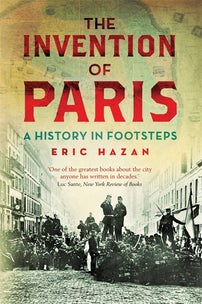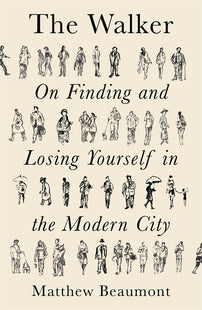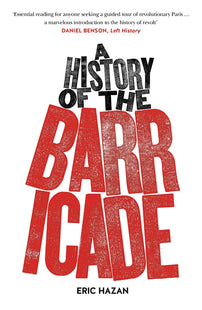‘Psychogeography of the Boundary’
Matthew Beaumont interviews the late historian of Paris, Eric Hazan.

Walking was an essential part of Hazan’s relationship with Paris and his role as a historian. In conversation with Matt Beaumont, they discuss Paris, history, and getting lost. This is published in memory of Hazan, who died in June 2024.
MB: The Invention of Paris: A History in Footsteps is a radical history of the metropolis from the perspective of the street, structured on a district-by-district basis, and it presents an extraordinarily rich and textured account of the city, cross-hatched with fascinating political and philosophical reflections. Could you explain the force of the term ‘invention’ in the title?
EH: It took a long time to find a suitable title. In the end, one of my friends had the idea of ‘the invention of Paris’. I like it because of its ambiguity: in English as in French, I think, it implies both that Paris has been invented, that it is an invention, in this instance my invention; and that it is itself responsible for a number of inventions, for example the barricade, which is the symbolic form of revolution. Paris is thus the object and subject of invention.
The accumulated knowledge about Paris is immense. The Bibliothèque Historique de la Ville de Paris, a beautiful Renaissance building in the Marais, is absolutely full of books about the city. Two or three lives would be insufficient time to read everything. But the literature on Paris is extremely specialized, as I have often observed in my life as a publisher. There are people who know everything about baroque theatre in Paris, or about nineteenth-century photography, or about Surrealist Paris. In my book I hoped to put together things that are generally separated, to collect things in a non-specialist fashion. It is a panoramic book, which tries to connect both geographical areas and historical periods of Paris that are often separated in accounts of the metropolis.
Paris has expanded in concentric layers, like an onion, which is exceptional. Unlike Berlin or London, Paris has historically evolved within a series of circular walls. (This remains the case: the périphérique is the last but by no means the least wall to enclose the city).
In Notre-Dame de Paris, by Victor Hugo, there is a beautiful description of this: the city becomes denser and denser, more and more crowded, then it jumps over the wall; the old wall is destroyed and a new layer is added to the city. This creates a rather special shape to the city, because in each layer the distinct quarters are nonetheless contemporaries of one another. For example, Faubourg St. Antoine in the eastern part of the city, a popular, working-class district, and Faubourg Saint Honoré in the west, an elegant, fashionable one, both developed in the second half of the eighteenth century. The entire Faubourg layer dates from this time.
An onion, to return to the metaphor you use, is proverbially empty at its centre. It doesn’t have a heart. Is that true of Paris?
No; at least, not historically. The heart of Paris used to be the Île de la Cité. Then Haussmann destroyed it in the mid-nineteenth century, when he re-engineered the city. Not everything Haussmann did was damaging, but that was catastrophic. The L’Île de la Cité, which was full of little streets and which contained numerous churches, had been the most dense and complicated part of the city. But Haussmann hated it because it was poor and dirty. So, he demolished it, leaving only Notre Dame, and instead constructed the Préfecture de Police, the Palais de Justice and a hospital.
The crucifix, the sword and the scalpel… The state was thus installed at the centre of the city, and its most vital, picturesque culture was completely destroyed. For this reason, Parisians have forgotten that the Île de la Cité was originally the heart of the city.
[book-strip index="1"]
Is the process of Haussmannization the defining moment of modernization, of modernity, in the history of Paris?
There have been two ruptures in the history of Paris. One was Haussmann; the other was Pompidou. Haussmann had significant military interests when he redesigned Paris in the mid-nineteenth century. To state this, though, is to oppose most contemporary French historiography, which relegates these motives to a mere paragraph of his biography. (This goes together with a rehabilitation of Napoleon III, who is currently regarded not as a criminal but as a philanthropist.)
Haussmann was manifestly guided by military thinking. Take, for instance, the implantation of the Place de la République. At the centre of an area particularly prone to rioting in the nineteenth century, Haussmann inserted an army barracks and built vast avenues leading to Montmartre in the north and to the east. He created a strategic point, and militarized the centre of Paris.
But once this has been admitted, it should be said that Haussmann was not as rough as he could have been. His brutal attempts to penetrate the city, like the Boulevard de Sebastopol or the Boulevard de Strasbourg, left some of the old quarters on either side relatively untouched. He could have destroyed them completely, but he didn’t. The destruction of the Île de la Cité and of the Place de la République are two of the great urbanistic crimes, but in spite of this Haussmann had some aesthetic sense.
The second rupture was Pompidou, in the 1960s, who insisted that Paris should be adapted to the automobile. He managed to build an expressway along the Seine; and he planned, among other things, to concrete over the Canal Saint Martin and construct a four-lane road, though fortunately he died too soon to implement these ideas. He was positively enthusiastic at the thought of destroying entire quarters, like Belleville. Like Haussmann, then, Pompidou waged a class war against Paris. His reforms to the city were a gesture of hate. He took popular, working-class quarters, ones that didn’t vote for the correct party, and reorganized them pitilessly.
So Paris changed a lot in the 1960s, and not least because, unfortunately, French architecture was at its lowest point. Today, the architecture is a good deal better, though urbanism, urban planning, remains extremely destructive.
At present, the spaces of Paris, like those of London and other cities, are undergoing an unprecedented process of privatization…
Yes, certainly. Everything is being privatized. Even the Post Office, an emblem of the public sphere, will be privatized in the near future. There are no more public spaces. Sarkozy is always speaking about le grand Paris. In the current campaign for the regional elections, which the Right is more or less losing, he has advised his Parisian team to talk to people about le grand Paris, on the grounds that the Left does not talk to them about it. But all his projects for le grand Paris, like the plan to extend Paris to Le Havre along the Seine, are forms of subterfuge. They are intended to encourage people to travel from the part of the city where they live to the part of the city where they work without crossing the centre of Paris.
In the meantime, the working-class quarters inside the périphérique have been reduced to the north-eastern area of Paris, the 18th, 19th and 20th arrondissements, which are mainly inhabited by blacks, Arabs and Asians. And even there a process of gradual gentrification is taking place. This is not however simply a negative change.
The whites who want to live there – les bobos [bourgeois bohemians] – are not necessarily affluent. Nor are they racist. In fact, gentrification of this kind can have the positive effect of protecting the presence of immigrants, of non-whites – so long as they do not drive the rents too high. Rising rents are a more effective means of expelling people than the police.
So where are the most vibrant areas of Paris at present? Where is the most fertile resistance to the privatization of space?
In precisely these areas. The Left Bank is completely awful. Nothing happens there. When I was young, everything happened there. We didn’t often cross the Seine. Now, there is no reason to go there, and I have very few friends who live there. It’s in a small area of the north east that it is vibrant.
If the périphérique wasn’t such a substantial barrier, Bagnolet, Montreuil, Saint-Denis would already have become the 21st, 22nd, 23rd arrondissements of Paris – and one day they will be. The problem, then, is to bridge that gap; or, more accurately, to bridge a double gap, consisting of the Maréchaux, the fortifications destroyed after the First World War, and the périphérique itself. At certain points, the gap is perhaps three quarters of a mile wide, and it comprises a complicated geography. It needs to be breached.
[book-strip index="2"]
In the book, you criticize what the city planners in Paris refer to as végétalisation. Can you tell me something about this?
This is one of the most lethal weapons presently deployed by those who wish to get rid of everything that is original and beautiful about Paris. Let me give you a couple of examples. Not far from La Fabrique, the publishing company I run, which is located in Belleville, there is a very attractive square with five extremely venerable chestnut trees. This place didn’t ask for anything; it simply asked to be left alone. But the planners have created a small garden by enclosing these chestnut trees with a metal fence. They have ornamented it with a selection of plants that have become ubiquitous in Paris. These horrible plants, which never flower, are quickly covered with a thick layer of dust. This has transformed the square into something which could be anywhere in the suburbs. Another example is the Rue des Rosiers in the Marais, that is, the main street in the old Jewish quarter of the Marais, which is currently being sterilized and destroyed by the proliferation of fashion boutiques. The planners, who are always doing deals under the table, more or less pedestrianised this street, which in France tends to be fatal. Then they ‘vegetalised’ it. In order to make it more picturesque, they created a central gutter, as in a medieval street, and introduced a series of potted plants. This prettification of the street has effectively destroyed its spirit. In Italy, they simply say, No more cars, and they don’t then change anything. In France, they feel obliged to change the pavement, to replace the old granite pavement with an absurd pink one, and to change the lampposts. In short, they Disney-fy it.
In English, your book’s subtitle is ‘A History in Footsteps’; in French, in a phrase taken from André Breton’s novel Nadja, it’s ‘Il n’y a pas de pas perdus’. There’s an implicit difference between them: the former is retrospective; the latter, which has something of the declarative quality of a manifesto, also looks to the future.
Yes, you’re right. I hate nostalgia, and I tried to avoid the official idea of patrimoine [heritage]. That does not mean however that I don’t respect the past. Of course I do. Walter Benjamin wrote that the historian should be a prophet who looks backward. One has to look backward in order to see forward.
So can footsteps reappropriate a city whose spaces are being progressively privatized?
I think so. Paris is now so dense that it is almost impossible to find any terrains vagues, any indeterminate spaces. If you do find one, then in a short time a notice will appear informing people that a shopping centre is about to be built there. There are indeterminate spaces in London, in Manhattan, and especially in Berlin. There are none in Paris. It’s too dense. So the areas that lie outside the périphérique must be annexed to the city. There are already places at which the périphérique is forced underground and, in consequence, this annexation has effectively taken place. But the trenches that define the limits of the metropolitan city cannot be bridged by those who hate and fear the people who live on the other side. Instead, footsteps can breach the boundaries between quarters, between the centre and the margins. If you are brave enough to cross the périphérique – and I have to admit that I don’t often cross it on foot – there are many things to explore.
This is what you have identified, in Situationist language, as a ‘psychogeography of the boundary’?
Yes. For a long time I have been struck by the distinctive identities of the different quarters of Paris. Crossing from one to another, the transition often seems extremely sudden. In some cases, one could trace the boundary between them with a piece of chalk. Here is the Marais, for example, and there is the quartier de la Bastille. In others, though, the transition seems much more gradual, much more imprecise. The eastern border of Montparnasse is for instance quite unclear. I am interested in these transitional spaces, these liminal spaces, which are too small to have a proper identity, and which aren’t defined by monuments or gardens. Ferragus, in Balzac’s novel of that name, occupies precisely one of these transitional spaces at one point, when he is old and devastated by all that he has experienced in his long life: ‘There, Paris is no longer; and there, Paris still lingers.’ In the 1830s, when the action is set, people gather there to play pétanque. Now I have a friend, the writer Jean-Christophe Baillie, who used to play pétanque on exactly that spot.
[book-strip index="3"]
In the histories of cities, women’s footsteps tend for obvious reasons to be far more restricted than men’s. Is a‘ history in footsteps’, then, necessarily a men’s history?
It’s true, it’s true… The poet Leon-Paul Fargue published a book called Le piéton de Paris in 1939, but there aren’t many women in it; and there is no book about ‘la piétonne de Paris’. It does seem to be a male activity.
You write movingly in your book about the Paris Commune. To what extent it is possible, in the present political climate, to combine individual challenges to the logic of the capitalist city with a collective challenge to it?
I have friends – much younger than I am – who think that meaningful political action is no longer possible in the metropolis. They are convinced that it’s too difficult collectively to reappropriate the city. My heart is against that way of thinking, although I must admit that the city has an extremely isolating effect. This applies to the banlieues too. Recently, I was at a meeting in Villiers-le-Bel, where there was rioting in 2007, and it was obvious that the black and Arab leaders of this small city found it difficult to make connections with the inhabitants of other similar places. But I am still hopeful that a link can be established between these people in the banlieues and the public sector workers demonstrating and striking against privatization. If this happens, the remaining days of the system will be easy to count.
So what is the future of Paris?
If one is pessimistic, one might imagine a future in which gentrification extends deeper into the banlieues, and the blacks and Arabs are pushed further and further from the centre; and in which the museum that is the historic centre of the metropolis expands to include, for example, Belleville. But I am not pessimistic by temperament. One way or another, I think that the ditch between Paris and the banlieues will be filled in, and another physically, politically and artistically active city will develop. The city’s centre of gravity will shift, as ever, to the north and east.
Eric Hazan is the founder-director of Editions La Fabrique. He is also the author of several books, some of which have been translated into English, including The Invention of Paris, A People’s History of the French Revolution
Matthew Beaumont is Professor of English Literature in the Department of English at University College London. He is the author of numerous books on walking including Nightwalking: A Nocturnal History of London, The Walker: On Finding and Losing Yourself in the Modern City, How We Walk: Frantz Fanon and the Politics of the Body.





